The proposed legislation includes tax credits, rule changes and grant dollars to lower carbon emissions and reduce household power bills. It could also have another effect: Making experimental green energy solutions, fantastical ideas that seem stolen from science fiction movies, more appetizing for investors to fund.
To the naked eye, direct air capture machines look like shipping containers stacked on each other, dominating open swaths of land. They are designed to eliminate carbon: either by sucking it out of the air and storing it deep underground or by converting it into something solid, removing it from the atmosphere permanently.
The technology is years away from widespread use because of engineering challenges, said Bruce Hill, the chief geoscientist at the Clean Air Task Force. In parts of the world that get very cold and are away from breaks in the Earth’s plates, companies would need to drill upward of 9 miles deep to reach 750 degrees. The deepest anyone has ever drilled into the earth is almost 7.5 miles, Hill said.
But concrete makers are often small, mom-and-pop businesses that are reluctant to change and too cash-strapped to invest in retrofitting their facilities, McLaughlin said. The spending bill offers a 30 percent tax credit to any manufacturing facility that wants to retrofit its operations to be at least 2o percent less climate emitting. It also provides grant funding to modernize technology.
The bill “sort of turbo charges the investment opportunity for them,” she said. “There’s a moment when they sort of say: ‘Okay, we can’t not do this, it would be just stupid of us not to.’”
Small scale, zero-emission nuclear plants could be used to power factories or small communities with the versatility — but not the pollution — of natural gas plants. The Act frees up funding for some of these projects, which would launch in the next few years.
Scientists have been working for decades to replicate that process in the lab, producing unlimited clean, safe renewable energy at a low cost. Scientists remain a long way off from reaching this goal, but the Inflation Reduction Act invests hundreds of millions of dollars in continued research.


